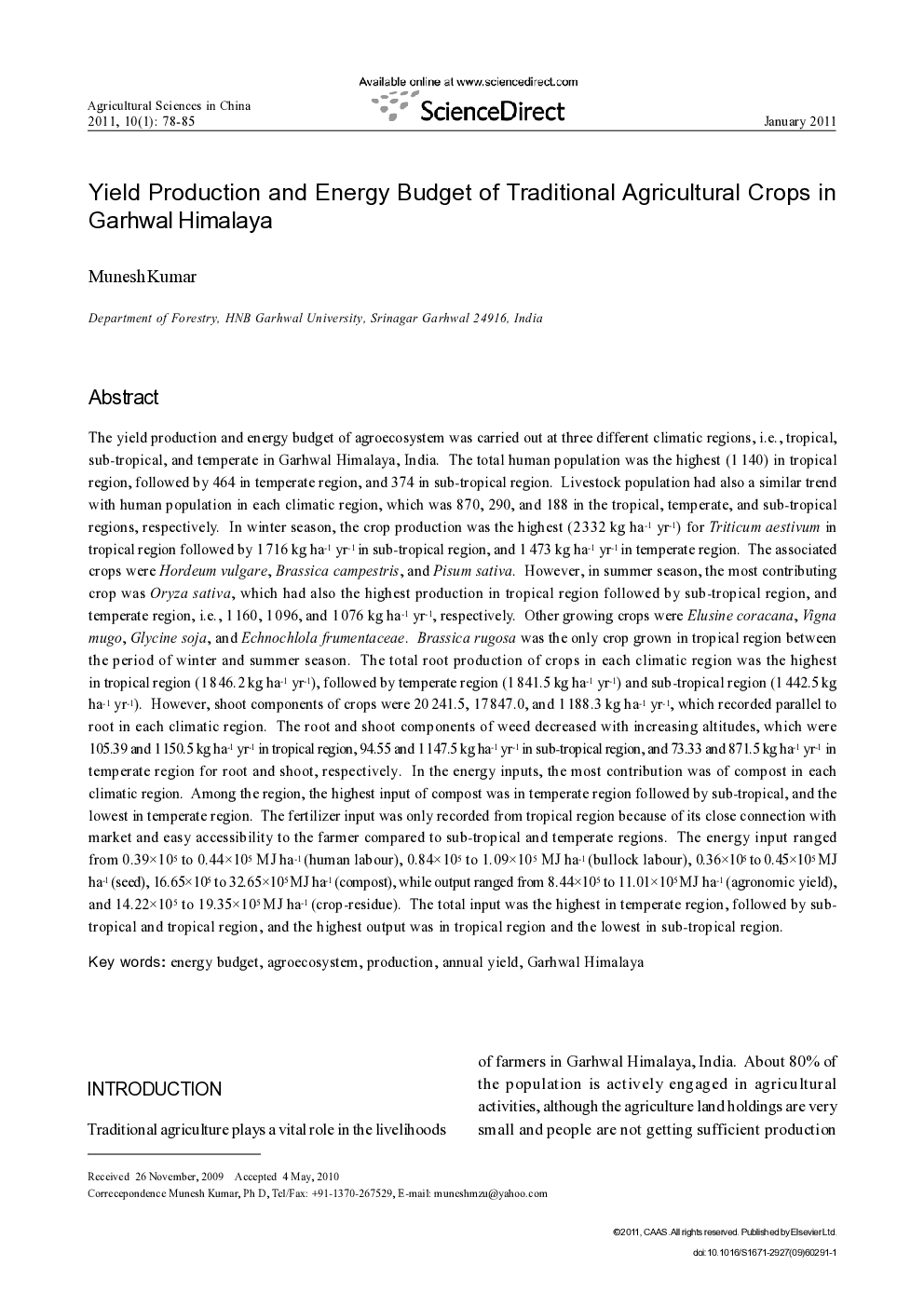| Article ID | Journal | Published Year | Pages | File Type |
|---|---|---|---|---|
| 4489885 | Agricultural Sciences in China | 2011 | 8 Pages |
The yield production and energy budget of agroecosystem was carried out at three different climatic regions, i.e., tropical, sub-tropical, and temperate in Garhwal Himalaya, India. The total human population was the highest (1 140) in tropical region, followed by 464 in temperate region, and 374 in sub-tropical region. Livestock population had also a similar trend with human population in each climatic region, which was 870, 290, and 188 in the tropical, temperate, and sub-tropical regions, respectively. In winter season, the crop production was the highest (2 332 kg ha−1 yr−1) for Triticum aestivum in tropical region followed by 1716 kg ha−1 yr−1 in sub-tropical region, and 1 473 kg ha−1 yr−1 in temperate region. The associated crops were Hordeum vulgare, Brassica campestris, and Pisum sativa. However, in summer season, the most contributing crop was Oryza sativa, which had also the highest production in tropical region followed by sub-tropical region, and temperate region, i.e., 1160, 1096, and 1076 kg ha−1 yr−1, respectively. Other growing crops were Elusine coracana, Vigna mugo, Glycine soja, and Echnochlola frumentaceae. Brassica rugosa was the only crop grown in tropical region between the period of winter and summer season. The total root production of crops in each climatic region was the highest in tropical region (1846.2 kg ha−1 yr−1), followed by temperate region (1841.5 kg ha−1 yr−1) and sub-tropical region (1442.5 kg ha−1 yr−1). However, shoot components of crops were 20241.5, 17847.0, and 1188.3 kg ha−1 yr−1, which recorded parallel to root in each climatic region. The root and shoot components of weed decreased with increasing altitudes, which were 105.39 and 1150.5 kg ha−1 yr−1 in tropical region, 94.55 and 1147.5 kg ha−1 yr−1 in sub-tropical region, and 73.33 and 871.5 kg ha−1 yr−1 in temperate region for root and shoot, respectively. In the energy inputs, the most contribution was of compost in each climatic region. Among the region, the highest input of compost was in temperate region followed by sub-tropical, and the lowest in temperate region. The fertilizer input was only recorded from tropical region because of its close connection with market and easy accessibility to the farmer compared to sub-tropical and temperate regions. The energy input ranged from 0.39×105 to 0.44×105 MJ ha−1 (human labour), 0.84×105 to 1.09×105 MJ ha−1 (bullock labour), 0.36×105 to 0.45×105MJ ha−1 (seed), 16.65×105 to 32.65×105MJ ha−1 (compost), while output ranged from 8.44×105 to 11.01×105MJ ha−1 (agronomic yield), and 14.22×105 to 19.35×105MJ ha−1 (crop-residue). The total input was the highest in temperate region, followed by subtropical and tropical region, and the highest output was in tropical region and the lowest in sub-tropical region.
